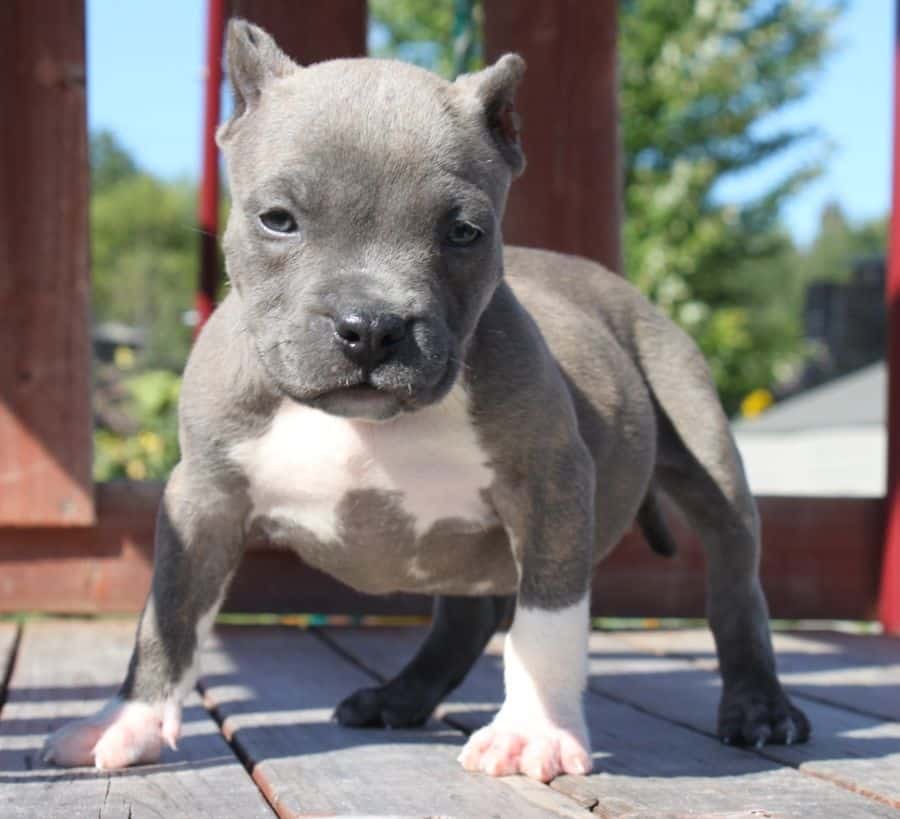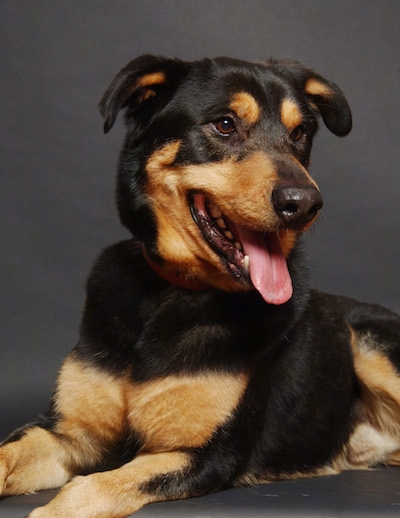In this post:
- 1. Don’t judge a dog by its name
- 2. She makes a great exercise partner!
- 3. She’ll be your kid’s best friend
- 4. She’ll have your back
- 5. She’s a looker… and low-maintenance!
- 6. Pocket Pits are more expensive than purebred Pitbulls
- 7. Get your Mini Pitbull from a reputable breeder
- 8. She’s prone to some health problems
- Conclusion

Pocket Pitbull is a mixed dog breed-a cross of the American Pitbull Terrier and the Patterdale Terrier, also known as Miniature Pitbull. It's a small-sized dog breed at about 12 to 16 inches tall, weighing between 11 to 22 pounds. The lifespan of the Mini Pitbull is around 11 to 13 years.
So why are these dogs all the rage, and what else should you know about them?
Check it out:
1. Don’t judge a dog by its name
Don’t let the name fool you; Pocket Pitbulls aren’t actually tiny bundles you could fit in your pocket (they have nothing on Teacup Chihuahuas), they’re just a smaller version of the parent breed, the American Pitbull Terrier.
Mini Pitbulls inherit their short stature from their Patterdale parent. As mentioned above they usually grow to between 12 – 16 inches (30.5 – 40.5 cm) tall. If they grow any taller than this, they are simply considered a Pitbull mix.
Their small size makes them a great choice for an individual or a family who would like to get a Pitbull but are put off by their size.
Bear in mind, though; Miniature Pitbulls are still muscular and strong. They can weigh between 11 – 22 pounds (5 – 10 kg), so don’t kid yourself thinking this dog will be light as air and easy to train to walk on the leash.
2. She makes a great exercise partner!
They may be small, but boy can they go. It figures – this is a cross between two very active, working breeds. The American Pitbull Terrier was bred for its strength and athleticism and used as a hunting dog, while the Patterdale Terrier was bred to be a “tough as nails” hunter of ground-dwelling animals.
So, if you’re thinking of getting a Mini Pitbull because they’ll require less exercise than an American Pitbull, think again!
These are dogs that need at least 1 hour of vigorous exercise a day. They also fit in better in a house with a garden where they can run and play.
3. She’ll be your kid’s best friend
Between the Patterdale’s playfulness and the Pitbull’s gentle “nanny dog” nature Pocket Pitbulls make great companions for children when properly trained.
I wouldn’t recommend these dogs for very small children, however, as they are strong, active dogs – a boisterous young puppy could easily knock over a very small child.
You should always supervise your child around your dog just to be safe. It is also necessary to teach children how to behave around dogs, for example how to approach her, pet her, and when to leave her alone.
4. She’ll have your back
The Mini Pitbull takes after its Patterdale parent in that she is usually a very good watchdog and will bark to alert you of an intruder. This instinct comes from a strong desire to protect their territory and their family.
You should make sure that this behavior is always kept in check, though. While you may want a guard dog, you will need to teach her not to be overly territorial to the extent that she may attack whoever walks through the door.
To do this, you must show this dog you are the pack leader. Otherwise, she may well try to rise to the top herself, which is where problems can occur.
5. She’s a looker… and low-maintenance!
This dog’s coat makes her quite the looker. It is incredibly shiny and smooth and can be white, cream, tan, brown, black, or gray.
What’s more, as they descend from short-coated parents, Pocket Pits have a very short, low-maintenance coat. This is great news for you, as it doesn’t need frequent grooming. Yipee!, I hear you cry…
6. Pocket Pits are more expensive than purebred Pitbulls
Since these dogs are considered “designer dogs” and they are rarer to come by than purebreds, they are much pricier. So, if you want a Pocket Pitbull, you’ll have to be prepared to pay a little more than you would for a purebred Pitbull.
While a purebred Pitbull usually costs about $500, you can expect to pay between $1500 – $2500 for a Miniature Pitbull.
👉 Related Reading: Top 10 World’s Most Expensive Dog Breeds
7. Get your Mini Pitbull from a reputable breeder
Unfortunately, there are always irresponsible breeders out there, and you have to be really careful when there’s a lot of profit involved as there is with this breed.
If you can, try to get a referral from someone you know such as a friend or your vet.
If you can’t find someone this way, it’s worth having a look on AKC Marketplace. Here you can search for the breed you want and read in detail about the breeder as well as view photos of the puppies.
👉 Related Reading: What important questions to ask a dog breeder?
How to recognize a reputable breeder
To make sure your Pocket Pitbull comes from a reputable breeder that puts quality first, here are a few things you should know:
A responsible breeder will:
- Want to meet you in person
- Happily show you where the puppy was raised
- Introduce you to the puppy’s parents and the rest of the litter
- Have dogs that look clean and healthy in a spacious environment
- Explain the potential genetic health problems and be able to show documentation that the puppy’s parents and grandparents are free of any genetic diseases
- Ask you questions regarding why you want a dog and how you will take care of her
- Require you to sign a contract saying you will spay or neuter the dog unless showing it
8. She’s prone to some health problems
As with any dog breed, Pocket Pitbulls are prone to a few health problems that they can inherit from their parent breeds.
As I already mentioned, make sure you choose a high-quality breeder that can provide evidence of healthy breeding and has clearly taken good physical care of the puppy. These assurances mean your Mini Pitbull is more likely to be a healthy pup.
Of course, to stay healthy, she will need regular exercise and a good quality dog food. There are also certain ingredients you can look out for in food to prevent her developing health conditions or help with existing ones.
👉 Related Reading: 5 Best Dog Food For Pitbulls in 2025
Here are the Pocket Pitbull’s main health concerns along with how diet can help prevent or alleviate them:
Hypothyroidism
This condition can occur in Pitbulls and causes low hormone levels, leading to lethargy, weight gain, and a dull coat.
Hypothyroidism can deplete your dog of basic nutrients, so it’s important that she gets a healthy, balanced diet, which means a dog food that includes a range of fruit and vegetables to provide her with much-needed vitamins and minerals.
Iodine is also beneficial for thyroid health, so look out for kelp, seaweed, and fish.
Hip dysplasia
This condition, common in Pitbulls, involves abnormal growth of the hip joint, which can lead to pain and even lameness, usually in a dog’s senior years. Diet and lifestyle can certainly help towards alleviating this condition.
Maintaining a healthy weight in your dog is essential, as the less weight on those joints, the less strain on those joints.
There are also dog foods specifically designed to promote joint health, which usually include glucosamine and chondroitin as well as high levels of omega-3 oils. You can feed lower amounts of these nutrients to a younger dog to keep her joints healthy, while an older dog already suffering from joint pain can do well on a food with higher amounts.
Heart disease
From the Patterdale side, the Mini Pitbull is prone to a few types of heart disease. Symptoms can include:
- Coughing
- Weight loss
- Difficulty exercising
- Loss of appetite
- Breathing difficulties
- Fatigue
- Trouble sleeping
She will need an annual heart checkup which can check for heart murmurs or abnormal heart rhythms.
Keeping your dog at a healthy weight is very important, and her chances of developing heart disease are much higher if she is overweight or obese.
She should also have a diet low in sodium, as an excess causes fluid buildup and puts a strain on the heart.
Omega-3 fatty acids can also help dogs with heart disease. Look out for foods with fish or flaxseed oil, as these are rich in omega-3s. This cannot prevent the condition, however.
Eye problems
Miniature Pitbulls can suffer from a number of different eye problems, most of which can be painful, and some can even cause blindness if not treated on time.
So, as well as their heart, they will also need their eyes checked yearly.
While not a preventative measure, there are some fruit and vegetables rich in certain antioxidants that can help your dog’s eyesight. These include:
- Blueberries
- Broccoli
- Sweet potatoes
- Kale
- Carrots
- Eggs
- Cold water fish (e.g. salmon or sardines)
Skin allergies
This dry, itchy ailment comes from the Pitbull side and usually affects their belly, ears, feet, and the folds of their skin. It can occur due to flea allergies, seasonal allergies, or food allergies.
If you suspect that food allergies are the culprit, it is worth trying her on a grain-free food, as grains are a common allergen. Another option is a Limited Ingredient food, which can help narrow down what she is allergic to.
Conclusion
Pocket Pitbulls are becoming popular additions to households across the US, and more and more people are considering owning one. So, it’s important to be aware of what to expect from these dogs.
Mini Pitbulls aren’t teacup size as you might expect – they are small but still very muscular dogs that look much like a Pitbull. Despite their small size, they have high energy levels and require lots of exercise and play.
These dogs are great with kids as they are loyal and protective. This instinct should always be kept in check, however, as Pocket Pits could easily become overly territorial.
They are much more expensive than a purebred Pitbull, so you should be prepared to spend more, and always make sure the breeder is responsible.





